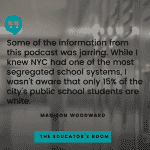Have you signed up for The Educator’s Room Daily Newsletter? Click here and support independent journalism!
I recently learned a new statistic that deeply surprised me: In the past three midterm elections, 33% of the teachers in my state’s union did not vote. Although this generally matches or beats the state-wide voter turnout trends – 64% of Minnesotans voted in the 2018 midterms, and only 50% voted in the 2014 midterms – I was still shocked to learn that one-third of teachers in the state have been sitting out of midterm elections. This November, thousands of local and state positions across the country are up for a vote. From governorships to school boards, state attorneys general to county judges, so many positions on the ballot will have a real effect on teachers, schools, and students. As the November 8th midterms rapidly approach, it’s time for teachers to recognize the power of our voting block and to make sure we are active voters in our communities.
Vote to Support Education Initiatives
Overall, teachers as a voting block share a common stance on many issues, including education funding, student mental health, and collective bargaining. At a baseline, teachers see the effects of underfunded schools every day. Teacher wages have not risen to match inflation and the cost of living, and in many states, pay for educational support professionals and paraprofessionals is not a liveable wage. Our schools lack supplies, technology, counselors, and aides, but per-pupil state aid has continued to fall over the last 20 years.
Governors and state legislatures directly affect education funding – they set state budgets and determine how much state money to invest in public schools. There are governor elections in 36 states this November, along with key seats up for grabs in all 50 state legislatures. These state-wide positions will shape the future of public schools across the nation, and it’s fundamental that teachers show up to vote for their futures.
Vote to Protect Collective Bargaining
But what power do state lawmakers really have? Take Iowa, for example. For 40 years, Iowa had a collective bargaining law in place that protected union negotiating. In November 2016, however, Republicans won a majority of seats in the state senate and maintained a majority in the House and the Governor’s office. Just two months after the new legislatures had been sworn in, House File 291 became law and stripped unions of most of their bargaining rights. Public-sector unions are now limited to negotiating base pay and are banned from negotiating issues such as health insurance, leaves of absence, and evaluation procedures. Tammy Wawro, president of the Iowa State Education Association, said during the debate on the bill, “This isn’t union-busting. [This bill] goes further. It’s profession-busting.” It’s true – states like Wisconsin have seen the deterioration of the teaching profession after Republican Governor Scott Walker signed Act 10 into law, effectively eliminating collective bargaining for most unions.
In the last year alone, we have seen numerous examples of why collective bargaining and negotiation are some of the most important political levers teachers hold. In Columbus, striking teachers were able to negotiate a 4% raise, class-size caps, parental leave programs, and HVAC upgrades. In Seattle, teachers negotiated better pay and workload protections for school staff after a 5-day strike. Here in Minneapolis, educators went on strike for two weeks to secure higher pay for paraprofessionals and protections for teachers of color. Teachers’ unions don’t just fight to make their work environments better; they fight to make schools better and safer for students and staff as well. Just as we have seen nurses’ unions fight for better working conditions and better pay, we must recognize the importance of collective bargaining not just for our professions but for the communities and schools we serve. Collective bargaining is a right we cannot lose, and that means, for the most part, voting for left-wing candidates who pledge to protect it.
Vote Democrat to Protect our Schools
So let’s just say it – for the most part, Republican candidates are proposing tax cuts, less education spending, and programs that could undercut public education altogether, like vouchers or school choice. Here in Minnesota, Republican gubernatorial candidate Scott Jensen has said some pretty alarming things about education. He’s called public schools “broken,” and claims vouchers are the only way to fix them. Furthermore, conservative PACs are spending millions on school board races and promoting new talking points such as “parental rights.” On the other hand, teachers’ unions have overwhelmingly endorsed Democrats in both primaries and midterm elections. Therefore, if we want to maintain both the ideals of public education and our livelihoods as professionals, teachers need to vote on November 8th and make our voices heard.
It’s Okay to Talk About Voting
But this is where it gets tricky – mixing politics and teaching. Teachers are programmed to be non-partisan, which we often confuse with being apolitical. Voting itself is non-partisan, but it is political. Unfortunately, culture wars surrounding partisan flash points like Critical Race Theory and gender identity continue to blur these lines, seeking to further politicize our professions. But wearing an “I voted” sticker or talking about elections with our colleagues is not partisan in the least. We can start by encouraging our colleagues to vote or check in to see if they have a voting plan. Simple questions in the copy room like “Do you know where your polling place is?” or “Did you know that early voting is now open?” can lead the way into more complex conversations about voting. I even think that pointing colleagues in the direction of research about key state-wide races and encouraging them to vote for Democratic candidates in order to protect unions and school funding is appropriate. Although we as teachers have been taught to shy away from anything political, voting is a political act, and we need to make sure we are taking a stand together.
This brings me back to the original statistic that led me down a rabbit hole of voter statistics. In the past three midterm elections, 33% of the teachers in Minnesota’s teachers’ union did not vote. Although it matches overall voter turnout trends, why was this statistic so soul-shaking for me? Perhaps I live in a bubble of social studies teachers who spend our lunch hours talking about politics, world affairs, and voting. There are so many reasons why people don’t vote – a lack of candidates that resonate with their stances on key issues or the everyday life circumstances that get in the way. Recent right-wing propaganda about stolen elections and voter fraud serves to politicize and limit voting even further. But I thought that teachers, who intrinsically care about the well-being of our students, schools, and communities, would turn out to vote in higher numbers than the public. We need to be active teacher-voters to protect our collective bargaining rights so that we can make changes for the well-being of our students, schools, and communities. So check in with your colleagues, and make sure they are registered to vote. Ask them if they have a voting plan. And be a teacher who votes.

Kristen Sinicariello is currently in her seventh year of teaching at a high school in Minneapolis, Minnesota. As a Social Studies teacher, she is passionate about taking a diverse approach to history while helping students unpack bias in a rapidly changing world. Before stepping into the classroom, Kristen spent time as an outdoor educator and wilderness guide, and continues to find most of her opportunities for learning and personal growth in the outdoors. Currently she also keeps busy as a girls soccer coach, a union communications leader, and a Social Justice Club supervisor.
Editor’s Note: If you enjoyed this article, please become a Patreon supporter by clicking here.






